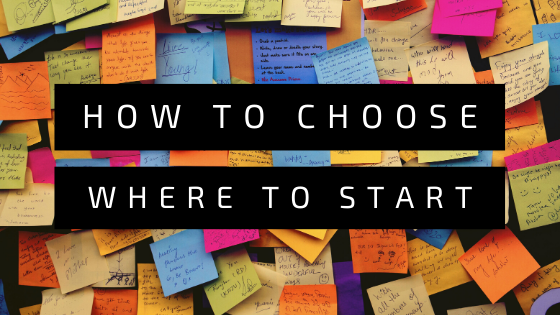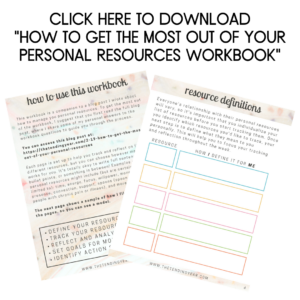Before we jump into the blog post, I want to quickly let you know that I’m currently accepting new one-on-one coaching clients who want a little extra guidance with changing their productivity habits. You can read more about my coaching practice here and book a session here. You can also download a FREE guide to habit formation and maintenance by subscribing to The Tending Letter in the pink box below this post. Thanks for your time, and enjoy the blog post!
Do you ever go to your desk, write a to-do list, and then sit there overwhelmed with the many possibilities of where to start?
I’m literally a productivity coach and I still sometimes feel nervous about deciding where to start when I sit down to work, so I am betting that you sometimes experience this, too!
Lucky for us both, I’ve developed a 4-step how-to guide for deciding where to start. Below, I’ll teach you how to identify potential to-do tasks, evaluate where each task lands on a priority plan, do an inventory of your personal capacities, and ultimately make an informed decision so you can get started!
Step 1: Take time to write a comprehensive list of tasks you’d like to accomplish
Set aside some time (perhaps a 25-minute Pomodoro session?) to do a brain dump of all the tasks that you’d like to accomplish. You should be specific and break your tasks down into steps. For example, instead of writing “write dissertation chapter” as potential a to-do task, write the actual steps required to accomplish that goal, such as brainstorming topics, drafting an outline, doing a mind map or concept map, writing a first draft, reverse outlining your draft, etc.
Here is my list of to-do tasks that prompted this post in the fist place. They all pertain to my dissertation:
- Write abstract
- Write acknowledgments
- Update list of figures
- Update appendices
- Update bibliography
- Revise conclusion
- Update table of contents
- Review and update in-text citations
Step 2: Identify the labor required and rewards for each task on your list
Once you have your list, it’s imperative to recognize that not all of the tasks were created equal. In other words, each task will require you to do a different kind and amount of labor, and each task will offer you different rewards.
Here are some examples of types of labor:
- Some tasks may require you to brainstorm or be creative.
- Some tasks will require a lot of focus and decision making.
- Some tasks will take a long time or will require multiple work sessions.
- Some will be monotonous, and you find that easy and enjoyable.
- Some will be monotonous, and you find that incredibly boring.
- Some will be so rote for you that you may be able to do them while you’re doing other things, like listening to music or a podcast.
- Some tasks may require emotional labor or may make you feel upset, triggered, or fired up.
Here are some examples of rewards:
- Some tasks may have an approaching deadline, so you feel relief in completing it.
- Some tasks may not have a deadline, but you feel good getting it off your to-do list.
- Some tasks may be done quickly and leave you feeling a confidence boost.
- Some tasks will need to be completed first so you can build other tasks on them (i.e., write a draft, revise a draft).
- Some tasks will offer a higher return than others, in that they are more important to your audience, have an earlier deadline, or once completed you can exchange them for money or another reward.
Here’s how I measured the labor and rewards of my potential to-do tasks:
- Write abstract: Necessary, but it’s okay to save writing a draft of this til next week, will require draft & revision
- Write acknowledgments: This will be fun and tender to write! Save for when I want a win or to feel happy
- Update list of figures: Monotonous, can complete when I can’t focus on producing
- Update appendices: Monotonous, but will require me to re-read chapters and update numbering
- Update bibliography: This is going to be tedious and will require a lot of personal cajoling and treats and time/multiple work sessions. It doesn’t need to be done ASAP, but I shouldn’t leave it til last or I’ll be angry.
- Revise conclusion: Highest return and due soonest, but also difficult because requires constructing new content
- Update table of contents: Okay to complete later, monotonous, need to have dissertation done before I can do this
- Review and update in-text citations: Okay to do this later, will require looking up MLA rules, not priority, could do while listening to music
Step 3: Do a personal resource inventory
Although high stakes things like deadlines may dictate how you prioritize tasks, you should also take into consideration how your personal resources are doing. Personal resources are things like focus, energy, time, spoons, etc.
To do an inventory, ask yourself questions like the following:
- How is my ability to focus today?
- How much time do I have for this work session?
- What mood am I in?
- Would I be more successful with creative, playful, or reflective tasks, or theoretical tasks that require me to do some mental gymnastics?
- Do I need a quick win confidence boost of completing a task today, or can I truck through working on a long-term project?
- Where would I feel most physically comfortable working today? (i.e., at my desk, on the couch, at the kitchen table)
Step 4: Make a decision informed by steps 2 and 3, then get to work!
Once you have a grasp of what labor is required, what potential rewards you could achieve, and you’ve checked in with what personal resources you can allocate to your work session, it’s time to choose which task to prioritize!
Looking at my list, I chose to focus on revising my conclusion, because I felt energized and had the ability to focus, I knew I had an uninterrupted hour to work, and I also knew that out of all the to-do tasks, this one had the biggest impact and the soonest deadline. While I didn’t finish the task one hour, I did make major revisions that I know have set me up for success when I sit down to work on the conclusion again.
PS:
If you’re interested in doing a more developed inventory of your personal resources, click the image below to download my free How to Get the Most Out of Your Personal Resources Workbook
This blog is not affiliated with, associated with, or endorsed by the Pomodoro Technique® or Francesco Cirillo.
Don’t forget to subscribe to my twice a month newsletter below to get your FREE guide to habit formation and maintenance! You can read more about my coaching practice here and book a session here.


